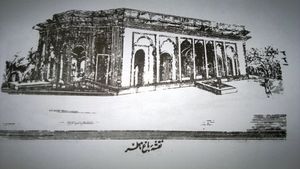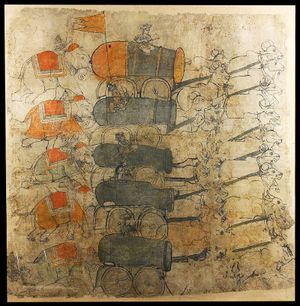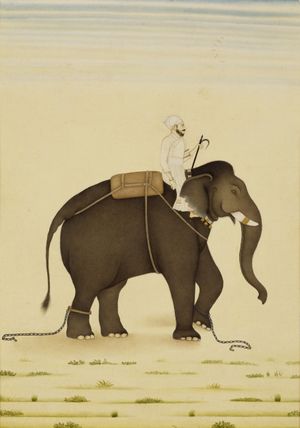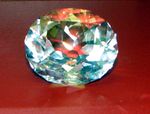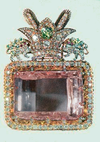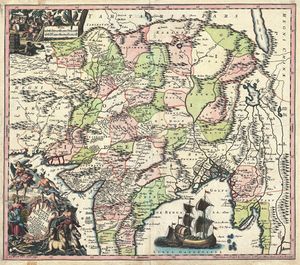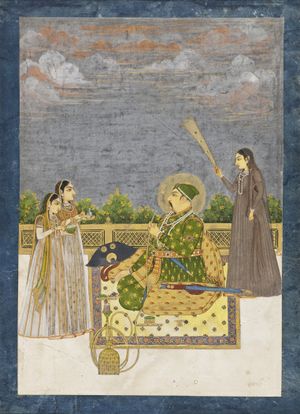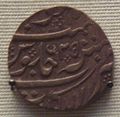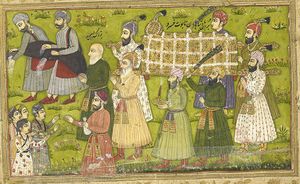محمد شاه
| محمد شاه | |||||
|---|---|---|---|---|---|
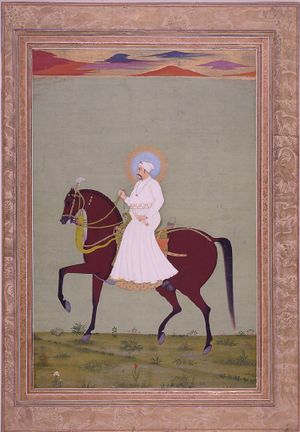 محمد شاه | |||||
| سلطان المغل الثاني عشر | |||||
| العهد | 27 سبتمبر 1719 – 26 أبريل 1748 (28 سنة 212 يوم) | ||||
| التتويج | 29 سبتمبر 1719 في تاجپور، الآن Samastipur district, Darbhanga division, بيهار، الهند | ||||
| سبقه | شاه جهان الثاني | ||||
| تبعه | أحمد شاه بهادر | ||||
| الوصي | Syed Brothers (1719–1722) | ||||
| وُلِد | 17 أغسطس 1702 فاتحپور، سلطنة المغل | ||||
| توفي | 26 أبريل 1748 (عن عمر 45) دلهي، سلطنة المغل | ||||
| الدفن | ضريح محمد شاه، نظام الدين أولياء، دلهي | ||||
| Consort | بادشاه بگم | ||||
| Wives | صاحب محل صفية سلطان بگم قدسية بگم | ||||
| الأنجال | شهريار شاه بهادر Ahmad Shah Bahadur تاج محمد أنور علي Badshah بگم جهان أفروز بانو بگم Hazrat بگم Sahiba-uz-Zamani | ||||
| |||||
| الأسرة | التيمورية | ||||
| الأب | خوجستا أختر جهان شاه | ||||
| الأم | قدسية بگم | ||||
| الديانة | الإسلام | ||||
ناصر الدين محمد شاه إرخواز، أبو الفتح ناصر الدين روشن أختر محمد شاه (17 أغسطس 1702 – 26 أبريل 1748)، كان سلطان المغل بين 1719 و 1748.[1][2][3][4] He was son of Khujista Akhtar, the fourth son of Bahadur Shah I. Ascending the throne at 17 with the help of the Sayyid Brothers, he later got rid of them with the help of Asaf Jah I. Hussain Ali Khan was murdered at Fatehpur Sikri in 1720, and Syed Hassan Ali Khan Barha was fatally poisoned in 1722.[5] Muhammad Shah was a great patron of the arts, including musical, cultural and administrative developments. اسمه الأدبي المستعار هو سعادة رنگيلا ("دائم السعادة") وكثيراً ما يشار إليه بإسم "محمد شاه رنگيلا".[6]
Although he was a patron of the arts, Muhammad Shah's reign was marked by great decline. The Mughals had already been showing decline for years, but the invasion by Nader Shah of Persia and the subsequent اجتياح ونهب عاصمة المغل would greatly accelerate the pace at which it was going. The course of events not only shocked and mortified the Mughals themselves, but also more foreign invaders، بما فيهم البريطانيون.
. . . . . . . . . . . . . . . . . . . . . . . . . . . . . . . . . . . . . . . . . . . . . . . . . . . . . . . . . . . . . . . . . . . . . . . . . . . . . . . . . . . . . . . . . . . . . . . . . . . . . . . . . . . . . . . . . . . . . . . . . . . . . . . . . . . . . . . . . . . . . . . . . . . . . . . . . . . . . . . . . . . . . . . .
النشأة
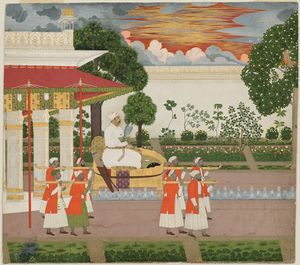
Muhammad Shah was born in 1702 in غزنة (in modern-day Afghanistan) to Prince Khujista Akhtar, during the reign of the سلطان المغل Aurangzeb. In the year 1707, his grandfather Bahadur Shah I had defeated and eliminated his own brother محمد أعظم شاه on 19 June 1707 at the Battle of Jajau, during another war of succession that followed after the death of his aged grandfather Bahadur Shah I his father was killed, and the 12-year-old prince and his mother were imprisoned by his uncle Jahandar Shah but spared from death. Handsome and quick to learn, his mother took good care of his education, while his father had enhanced his administrative abilities. Since the overthrow of Farrukhsiyar in 1719 many Mughal Emperors briefly ascended to the throne, but the Sayyid Brothers eventually chose 17-year-old Muhammad Shah to become the new Mughal Emperor.
الحكم
في 29 سبتمبر 1719، حصل على اللقب أبو الفتح نصير الدين روشن أختر محمد شاه and اعتلى العرش في الحصن الأحمر. His mother was given an allowance of 15 thousand rupees monthly for her needs, but the Sayyid Brothers kept the new emperor under strict supervision.
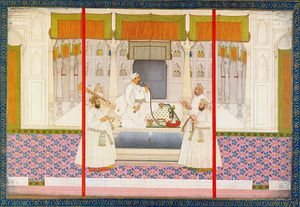
وزير المغل سيد حسن علي خان برها وشقيقه القائد العسكري و chief Syed Hussain Ali Khan Barha were very well aware that Asaf Jah I and his companions Qamaruddin Khan, Zain ud-din Ahmad Khan intended to dissolve their administration. The Sayyid Brothers quickly nominated an amateur Prince Muhammad Ibrahim, who claimed to be a Mughal Emperor but he was quickly defeated by the new loyalists of the young Mughal Emperor Muhammad Shah on 13 November 1720.
أتباعه
أثناء عهده، كان لمحمد شاه أتباع عديدون في أرجاء الامبراطورية.
محمد أمين خان طوراني كان قائد جيش المغل، قواته حلـَّت ادارة الأخوة سيد.
آصف جاه الأول عُيـِّن وزير سلطنة المغل في 21 فبراير 1722.
نواب أوده، سعادة علي خان قاد ودرّب معظم جيش المغل.
عليوردي خان، نواب البنغال الثري الأمين.
محمد خان بنگش، كان نواب فروخ آباد.
جاي سنغ الثاني كـُرِّم كـ زيج تكريماً لمحمد شاه.
دوست محمد خان، مؤسس نوابية بهوپال.
التطورات الادارية والثقافية
التقدم العلمي
During the reign of the Mughal Emperor Muhammad Shah, a significant scientific work known as the Zij-i Muhammad Shahi was completed by Jai Singh II of Amber between the year 1727 and 1735; it consisted of 400 pages.[7]
حروب المغل-المراثا اللاحقة
في عام 1740، Dost Ali Khan to Nawab of the Carnatic and Chanda Sahib faced the task of expelling the Marathas under Raghoji I Bhonsle, authorized by Shahu. Dost Ali Khan lost his life on 20 May 1740 at the Battle of Damalcherry in defence of Arcot and its populace, which was eventually looted and plundered. Chanda Sahib along with his garrison was captured and imprisoned in Satara. Chanda Sahib and his forces ferociously defended their rightful reams during the Siege of Trichinopoly and almost all the territories of the Nawab of the Carnatic despite being outnumbered substantially by the Marathas, their daunting efforts soon attracted the attention of the curious French East India Company official named Joseph François Dupleix.[9] dissatisfied by the Maratha occupation of the territories of the نواب كرناتكا، آصف جاه الأول led an expedition to liberate the Carnatic he was joined by سعادة الله خان الثاني وأنوار الدين محمد خان together they recaptured Arcot and initiated the Siege of Trichinopoly (1743), which lasted five months and forced the Marathas led by Murari Rao Ghorpade to evacuate the Carnatic.[9]
جيش المغل
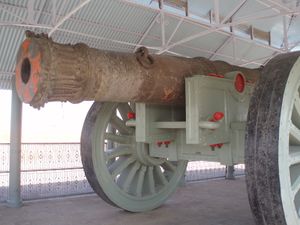
جيش المغل قبل عام 1739 كان يضم 200,000 فارس و 1,500 فيل، استخدم سلطان المغل محمد شاه ثمانية آلاف قطعة مدفعية، تجرها الفيلة والثيران.[10]
غزو نادر شاه
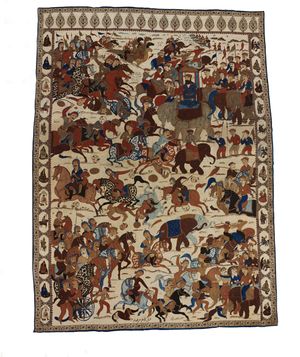
. . . . . . . . . . . . . . . . . . . . . . . . . . . . . . . . . . . . . . . . . . . . . . . . . . . . . . . . . . . . . . . . . . . . . . . . . . . . . . . . . . . . . . . . . . . . . . . . . . . . . . . . . . . . . . . . . . . . . . . . . . . . . . . . . . . . . . . . . . . . . . . . . . . . . . . . . . . . . . . . . . . . . . . .
غزو سلطنة المغل
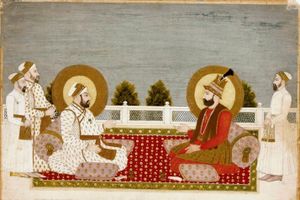
وفي 13 فبراير 1739 قام الفرس بقيادة العبقرية العسكرية نادر شاه، قائد الأفشاريين، الذين أطاحوا بالأسرة الصفوية، وهزم خصم الفرس اللدود، الدولة العثمانية عدة مرات، وبذلك أمّن الجبهة الغربية. والآن وجه ناظرَيه صوب سلطنة المغل الثرية الضعيفة. وفي عام 1739، قام نادر شاه بغزو سلطنة المغل، وهزم محمد شاه في معركة كرنال في أقل من ثلاث ساعات،[11] ثم زحف إلى عاصمة المغل دلهي، وبعد سلسلة من الأحداث، قام باجتياحها ونهبها بالكامل، واحتل معظم المناطق الشمالية من سلطنة المغل.
التبعات
Nader Shah's invasion destroyed what was left of the Mughal Empire and neared it to its end. After the invasion, the Mughals rapidly disintegrated. The weakness of the Mughal Army was clearly elaborated after this invasion. The Nawabs clearly could not even relieve their captured city of Delhi, which was the seat of their authority. The Mughals were completely looted of their wealth, and rebellions and disloyalty became commonplace.
العلاقات الخارجية
إثر غزو نادر شاه، سارعت الدولة العثمانية، عدوة الفرس اللدودة، باستغلال الفراغ الناشئ على حدودها الشرقية إذ سُحبت كل وحدات الجيش الفارسي إلى سلطنة المغل. أثناء تلك الفترة، راقب سلطان المغل محمد شاه عن كثب أفعال العثمانيين، كما تعاون مع السفير العثماني حاجي يوسف أغا حتى وفاة السلطان في 1748 بعد انتصار جيش المغل في معركة مانيپور (1748) ضد عدو آخر (أحمد شاه دراني).[12]
العائلة الامبراطورية
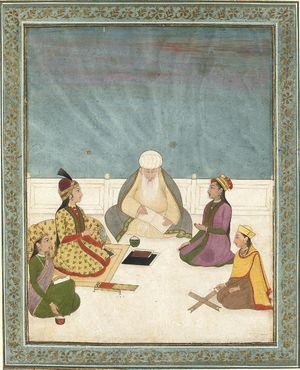
أحمد شاه دراني تزوج حضرت بگم، ابنة سلطان المغل المتوفي محمد شاه في عام 1757.[13]
A silver coin minted في عهد سلطان المغل محمد شاه من بومباي.
French-issued rupee in the name of Muhammad Shah (1719-1748) for Northern India trade, cast in Pondichéry.
وفاته
انظر أيضاً
الهامش
- ^ Buyers, Christopher. "India, The Timurid Dynasty genealogy". The Royal Ark, Royal and Ruling Houses of Africa, Asia, Oceania and the Americas. Retrieved 12 June 2009.
{{cite web}}: Italic or bold markup not allowed in:|publisher=(help) - ^ Rai, Raghunath (2006). History For Class 12: Cbse. Economics/vk India Enterprises. p. 3. ISBN 8187139692.
{{cite book}}: Cite has empty unknown parameter:|coauthors=(help) - ^ Keene, H. G. (2004). The Fall of the Moghul Empire of Hindustan, Ch. III, 1719–48. Kessinger Publishing. ISBN 1419161849.
{{cite book}}: Cite has empty unknown parameter:|coauthors=(help) Available here on Project Gutenberg. - ^ Sen, Sailendra (2013). A Textbook of Medieval Indian History. Primus Books. p. 193. ISBN 978-9-38060-734-4.
- ^ The Begums of Bhopal (illustrated ed.). I.B.Tauris. 2000. p. 18. ISBN 978-1-86064-528-0.
- ^ "Sitar - Google Search". google.com.pk. Retrieved 17 January 2014.
- ^ http://books.google.com.pk/books?id=740AqMUW8WQC&pg=PA278&dq=zij-i-muhammad+shahi&hl=en&sa=X&ei=AlEtVOzBB83natiygZgL&ved=0CCUQ6AEwAg#v=onepage&q=zij-i-muhammad%20shahi&f=false
- ^ Unknown (mid-18th century). "Elephants pushing cannons drawn by bullocks, Kota".
{{cite web}}: Check date values in:|date=(help) - ^ أ ب Jaques, T. (2007). Dictionary of Battles and Sieges: P-Z. Greenwood Press. ISBN 9780313335396.
- ^ https://www.google.ca/search?q=size+of+the+mughal+army+during+the+battle+of+karnal&oq=size+of+the+mughal+army+during+the+battle+of+karnal&aqs=chrome..69i57.11006j0j4&sourceid=chrome&ie=UTF-8#q=size+of+the+mughal+army+during+the+battle+of+karnal&tbm=bks
- ^ خطأ استشهاد: وسم
<ref>غير صحيح؛ لا نص تم توفيره للمراجع المسماةLater Mughal - ^ خطأ استشهاد: وسم
<ref>غير صحيح؛ لا نص تم توفيره للمراجع المسماةMughal-Ottoman relations Muhammed Shah - ^ Hoiberg, D.; Ramchandani, I. (2000). Students' Britannica India. Encyclopaedia Britannica (India). ISBN 9780852297605.
وصلات خارجية
 Media related to Muhammad Shah at Wikimedia Commons
Media related to Muhammad Shah at Wikimedia Commons
| سبقه شاه جهان الثاني |
سلطان المغل 1719–1748 |
تبعه أحمد شاه بهادر |









